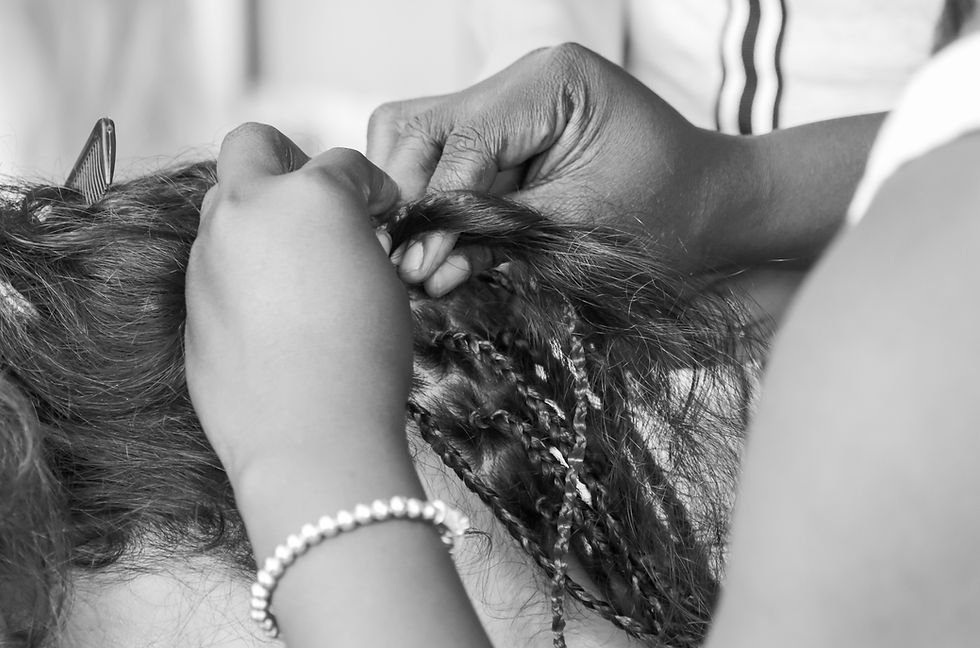Understanding Traction Alopecia
- hairblossomingeffe
- Jun 25, 2024
- 3 min read
Lori Brenae
Hair Educator

Hairstylists have been artistically showcasing lovely, intricate styles. While the hairstylist within me is intrigued by the creative designs, my twenty-five years of experience and knowledge makes me cringe when I see braids, locs, twists, and ponytails being installed very tightly, which are ultimately the cause of Traction Alopecia (al-oh-pee-sha), (TA). There are many factors when it comes to hair loss, but the focus of this straight-to-the-point topic will be what TA is, and how you can avoid it.
There are different forms of alopecia, however according to the American Academy of Dermatology (AAD), “anyone who frequently wears a tightly pulled hairstyle can develop hair loss… the medical term for this type of hair loss is Traction Alopecia.”
Now think for a minute about your current hairstyle or a hairstyle you enjoy wearing. Is it a high bun, tight ponytail, slick up-do; cornrows, locs, weaves/wigs, or braids that made your scalp hurt while you were getting it done and thereafter, or can see your hair pulling from your scalp tightly? If so, you are wearing a hairstyle AAD deems unhealthy for your scalp and hair’s integrity. If not, great you are on the right track to preventing TA.
Traction Alopecia comes from continuous pulling caused by the aforementioned hairstyles which mean genetics and scalp conditions are not responsible for this form of alopecia. Receiving back-to-back tight hairstyles weakens and inevitably damages the follicle from where hair grows.
While TA can cause embarrassing hair loss, as long as you remain in the early phase of it, there is a chance for hair regeneration. However, once follicles are damaged, its condition is irreversible. In this advanced stage, the scalp has scarred, slick bald spots are present (“without the presence of fine hairs”), and hair typically does not grow back.
What are the signs of Traction Alopecia?
Small bumps or pimples in the scalp
Broken hairs or patches around the forehead or in areas where hair is pulled tightly
A receding hairline
Redness, soreness, stinging, itching, inflammation, and pus-filled blisters on the scalp
How to Prevent Traction Alopecia?
1. Have your braider start your braid or twist ½ inch away from your scalp. (I know you want your money’s worth, but remember the goal is to prevent hair loss).
2. While it is important to wear scarves for protection while you sleep, or even if you are an everyday scarf wearer, make sure not to secure it too tightly since doing so prevents blood from circulating to the follicles. Instead, wear it loosely and purchase a larger size if needed.
3. Hydrate and lubricate hair while wearing braids, weaves, wigs or crotchets. The fabric of the synthetic hair is very dry, robs hair of moisture, and sometimes creates friction, which causes hair loss.
4. If your hair isn’t long enough to wear a loose high bun (or braided high bun), change your style.
5. To avoid tight cornrows, ponytails, braids, locs and other hairstyles, talk with your hairstylist before getting it done, so they won’t style too tightly. If they don’t listen, find someone who will.
6. Be patient and gentle with your hair, especially while detangling, combing and during extension takedowns. Also, try combing your hair with your fingers instead of a regular comb to avoid pulling at your scalp.
7. Moisturize, moisturize, moisturize your scalp and hair, (even while in a protective hairstyle), with our non-greasy conditioning and hydrating products like Silkening Hair Milk and seal-in the moisture with follicle stimulating oils such as our Chebe Hair Oil or with the Lite Herbal Balm, which is a much better version “hair grease”.
8. Consult a dermatologist or trichologist early if you detect a scalp and hair condition that does not go away on its own, and you’re concerned about it.
As the hair industry continues to evolve, the popular phrase, “healthy hair begins with a healthy scalp” remains accurate. Since Traction Alopecia is preventable, if you or someone’s hair you take care of suffers from this form of alopecia (and even if not), begin paying attention to how you handle and style the hair. As a hair care specialist, whether short, medium or long, seeing hair and scalp healthy and blossoming, will always be a better look regardless of what’s trending.
If you’ve gotten this far, thank you for reading this article. I hope it helped. Feel free to copy, paste the link, and share it.
Hair is important, but so is the health of your body, mental health, and spirit. Please take care of yourself! Remember Ecclesiastes 3:11, “He has made everything beautiful in its time" and you are beautiful! I will be chatting with you soon. Stay safe and enjoy your summer!
To view our products, visit Blossoming Effects | Quality Hair Care Products (hairblossomingeffects.com).
Photo Credit: Wix
Reference: American Academy of Dermatology (AAD)





Comments